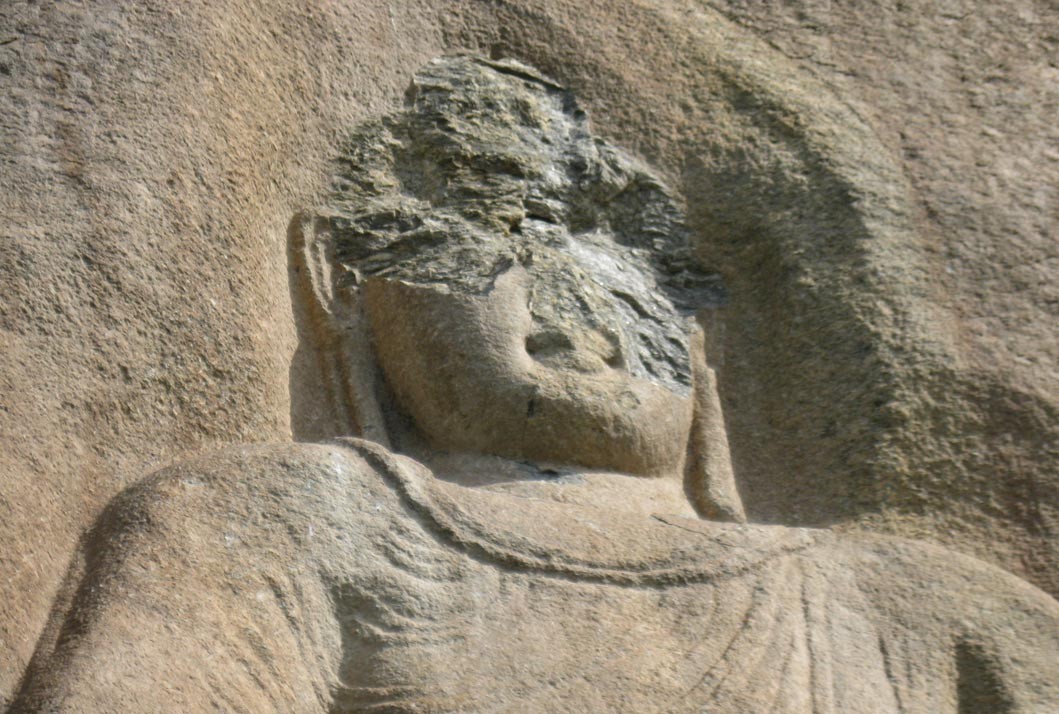
A peek into the history of once famous Buddhist sanctuary at Jahanabad in the Malam Jabba valley that became a notorious site of religio-political vandalism

The historic valley of Swat saw, between 2007 and 2009, a socio-religious crisis of the level which, most probably, it has not experienced in its centuries long spry and tumultuous history. It had become a spooky deserted house where shedding human blood was an easy and lucrative business. Beside human sufferings, the cultural heritage of the valley was also damaged. The once famous Buddhist sanctuary at Jahanabad in the Malam Jabba valley became the notorious site of religio-political vandalism.
Jahanabad not only houses the worldwide popular colossal image of Buddha but also remains of a stupa and three inscriptions. An impressive relief of another Buddhist deity called Bodhisattva Padmapani is also found in the complex. Well-known scholars, such as Aurel Stein and Giuseppe Tucci, have long visited and documented these sites of human memory. I would like to present here a detailed description of this socio-religious landscape while its twilight will be analysed in another attempt.
Jahanabad Buddha is known as second to the Bamiyan Buddhas in size. It is carved on the plain face of a huge boulder around at the middle of the mountain on the left side of the stream traversing the Malam Jabba valley. It is very much visible from the road on the opposite side, going from Mingora to Malam Jabba. The panorama below seems like in the palm of one’s hand. It looks as if the Buddha dominated and guarded the whole valley. The relief is said to have been effected in the 7th/8th century, a period which scholars term post-Gandharan. The Buddha is depicted in meditation pose.
At a little distance from the Jahanabad Buddha, there was another relief of Bodhisattva Padmapani. Padmapani represents one of the many forms of Bodhisattva Avalokiteshvara. The concept of Bodhisattva in Northern Buddhism is different from Arhathood in Hinayana Buddhism. Bodhisattva is an enlightened and spiritually awakened being who intentionally postpones nirvana, salvation from personal reincarnation and the resultant sufferings. Arhat, on the other hand, is an enlightened person who attains nirvana on death. Bodhisattva embodies compassion and mercy. He refuses nirvana so as to assist all sentient beings to get enlightenment and spiritual awakening.
Bodhisattva Avalokitesvara is the emanation of Dhyani Buddha Amitabha, one of the "‘group of five self-born’ celestial Buddhas who have always existed from the beginning of time" (Britannica). He is believed to have been busy in acts of creation, on behalf of Amitabha, between the departure of Buddha Sakyamuni and the advent of Maitreya, the future Buddha presently living in Tushita Heaven. Avalokiteshvara acts as a protector and savior. Padmapani as a form of Avalokiteshvara assumes the same attributes. He is ubiquitous in the rock art landscape of Swat archaeology. And his depiction in the vicinity of Jahanabad Buddha, sharing the same chronology, is important in this whole context. He is seated in Rajalisana, posture of kings.
Other important residues of the past from the Jahanabad Buddhist complex include the three inscriptions from sites known as Khazana-gat and Ubo-gat. They were first reported to Major Deane, Political Agent of Malakand Agency, since its formation in 1895. He referred to them in his article published in 1896. Shortly afterward, they were translated and published by German paleographer G. Buhler. British archaeologist Sir Aurel Stein visited and documented the inscriptions in 1926. He was of the view that these documents were lacking any value in terms of historical reconstruction.
Buhler’s translation is as follows:
1. "Alas! Transient are the aggregate constituents (of beings), whose nature is birth and decay! For, being produced they are dissolved; - their complete cessation is bliss."
2. "Not to commit any sin, to acquire merit, to purify one’s mind, - that is the teaching of Buddha."
3. "(Let him be one) who guards his speech, is well-restrained in mind, and commits no evil with his body. Keeping these three roads of action clear, one may gain the path taught by the Sages."
According to Stein these inscriptions belong to the early period of Kushana dynasty (1st-2nd centuries of the common era). If he is believed to be correct in his estimation, we may note that the inscriptions and carvings of the deities belong to periods quite apart both chronologically and doctrinally.
The above-mentioned inscriptions present gist of the Buddhist philosophy and worldview. The first one indicates the world-denying posture of Buddhism. Seeing the existence as ephemeral and a curse, it refers to nirvana as the highest ideal for human beings to be achieved. The remaining two communicate that speaking right, thinking perfect and observing good as valuable virtues should be internalised. Intriguing is it to compare them to the three kernel principles of Zoroastrianism e.g. good thoughts, good words and good deeds.
Synchronizing these dharmic verses and the Buddha and Bodhisattva images give an entire world of Buddhist ethics embodying harmony, peace, compassion and salvation. And it is via these sites of memory that one, who transcends spatio-temporal and socio-religious bias, would be able to feel a sense of tranquility.
Read also: Jahanabad Buddhist Complex after Taliban
However, it is unfortunate that all this heritage has become a socio-cultural and temporal ‘other’. No one is familiar with the inscriptions. The images are seen either as clues to hidden treasure or idols destined to undergo the decay they deserve. Against this backdrop, it would be of much interest to know what happened to the Jahanabad Buddhist establishment during the 2007-09 crisis. It will be presented, in continuation to this exposition, in the forthcoming article.
To be concluded